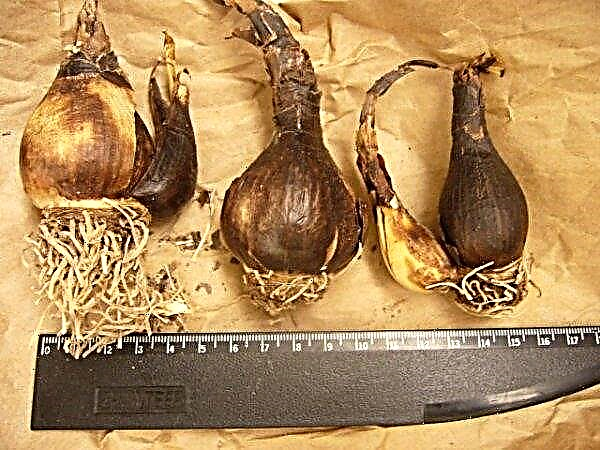Among the most dangerous diseases of cattle is pyroplasmosis, which can cause significant damage to a herd of cows. Having studied the characteristics of the disease, you can take the necessary preventive and treatment measures in advance.
What is this disease
Pyroplasmosis is a vector-borne disease of animals that is caused by parasites of red blood cells - "pyroplasm" or "babesia." The disease is also known as "Texas fever" or "chihir."
 The disease most often affects:
The disease most often affects:
- cows
- zebu;
- buffaloes.
Pathogen, sources and routes of infection
 Pyroplasm lives in the body of the tick and in the blood of the host animal, where it gets after a tick bite. There are parasites:
Pyroplasm lives in the body of the tick and in the blood of the host animal, where it gets after a tick bite. There are parasites:
- amoeboid;
- oval;
- round;
- pear-shaped.
Pyroplasm remains active outside the body at a temperature of +19 ... + 20 ° C during the day and up to two days at a temperature of +35 ... + 40 ° C. Pyroplasmosis is characteristic of the southern regions of all parts of the world where ticks live. In different areas, the tick is able to reproduce 2 or 3 generations.Did you know? Ticks can also be carried by dogs, horses and other animals.
Accordingly, 2 generations will provoke 2 outbreaks (in spring and summer), and 3 generations of ticks will lead to 3 outbreaks of the disease (in spring, summer and autumn). There are known cases of infection of an animal in a stall (without grazing), when ticks got inside with grass.
Symptoms
Pyroplasmosis is characterized by an acute course. The first signs of the disease appear on 10-15 days from the beginning of the grazing. The disease proceeds with characteristic symptoms:
- a sharp increase in temperature to +41 ... + 42 ° C;
- refusal of food, thirst, possibly lacrimation;
- increased heart rate (up to 120 beats);
- constipation, diarrhea;
- yellowness of the mucous membranes;
- urine is colored in shades of red;
- abortion in pregnant cows is possible.

Yellowness also affects the insides, however, this can only be revealed at autopsy.
Diagnostic Methods
During the incubation period (10-15 days), increased attention should be paid to the condition of the animal and to control body temperature. At the first suspicion, it is necessary to call a veterinarian who will make a diagnosis, taking into account a whole range of studies. The history of diseases, time of year and the epidemiological situation in the area are taken into account. Infection manifests itself in a smear of peripheral blood during the day.
A blood test shows:
- a decrease in the number of red blood cells to 2.5 million or less;
- hemoglobin reduction to 25–32%;
- an increase in lymphocytes up to 71%.
Spring pyroplasmosis usually proceeds easier than autumn or summer, respectively, the severity of symptoms will be weaker.Important! The blood of a fallen animal must be examined during the day, otherwise the analysis will not be informative!
Pathological changes
Studies of dead animals show the following picture:
- severe exhaustion;
- yellowing of fascia, tendons, subcutaneous tissue;
- poor blood coagulation;
- hemorrhages are found in the lymph nodes, as on the mucous surface of the abomasum;
- spleen, liver and kidneys are greatly enlarged and softened;
- very thick bile is found in the gallbladder;
- pulmonary edema, hemorrhages may be present;
- the brain and membranes are slightly edematous, often full of point hemorrhages.
 The heart of a fallen animal is enlarged, and the heart muscle is characterized by pallor and flabbiness. In the cavities is loosely coagulated blood.
The heart of a fallen animal is enlarged, and the heart muscle is characterized by pallor and flabbiness. In the cavities is loosely coagulated blood.Treatment
There is no special vaccine for treating pyroplasmosis in cows. Treatment is prescribed by a veterinarian depending on the condition of a particular animal.
General recommendations
After the onset of the first symptoms, it is necessary to isolate the sick individual. The animal should be protected by a canopy or in a stable, and the food should include good quality grass or hay.
A dietary supplement or injection of vitamin B12 is recommended.Important! Concentrated feed during illness should be excluded!

Special preparations
Specific chemotherapy includes one of the drugs:
- azidine 7% (injections 3.5 mg / kg subcutaneously);
- tripaflavin (or flavacridine) 1% (0.004 g / kg intravenously).
If the condition is serious, trypaflavin should be given in two divided doses, after 3-4 hours.
To dangerous ailments that affect the circulatory system of cattle, also include leukemia.
Also used:
- hemosporidin 2% (subcutaneous 0.5 mg / kg);
- pyroplasmin 5% (subcutaneously 1 mg / kg).
 Veterinarians additionally use symptomatic agents:
Veterinarians additionally use symptomatic agents:
- decoctions of flaxseed;
- laxative salts (with atony);
- heart medications (caffeine).
Immunity
Ill individuals receive non-sterile immunity and remain protected from the disease for 4-8 months. Antibodies in the blood of such animals are detected upon receipt of the results of analyzes of CSC and RIF. Preventive treatment is recommended even in animals with immunity.
Prevention
Prevention with pyroplasmosis is necessary and significantly reduces the risk of disease. There are agrotechnical measures to destroy the tick population in a particular area.
Farm owners must adhere to the following rules:Did you know? Pastures located at an altitude of 900–1200 m above sea level are completely safe because ticks are not there.
- grazing animals only on cultivated pastures where there are no ixodid ticks;
- cattle should be kept in stalls and regularly treated with acaricidal drugs (butox, permethrin and others);
- livestock should be transported to safe pastures in winter;
- if transportation cannot be avoided in summer or spring, animals are treated three times with acaricidal preparations with an interval of 5 days before the trip;
- in enzootic foci during an outbreak, animals are administered azidine and berenyl, which provides protection for 2-3 weeks.
 Private or small farm owners can reduce the risk of infection by changing pasture land. One solution is 4 shift plots and a change of grazing place every 25 days. It is worth starting the change of plots with the beginning of spring.
Private or small farm owners can reduce the risk of infection by changing pasture land. One solution is 4 shift plots and a change of grazing place every 25 days. It is worth starting the change of plots with the beginning of spring.
Timely prevention and proper treatment will reduce cattle losses from pyroplasmosis disease. Contact with an infected animal is not dangerous to humans.












